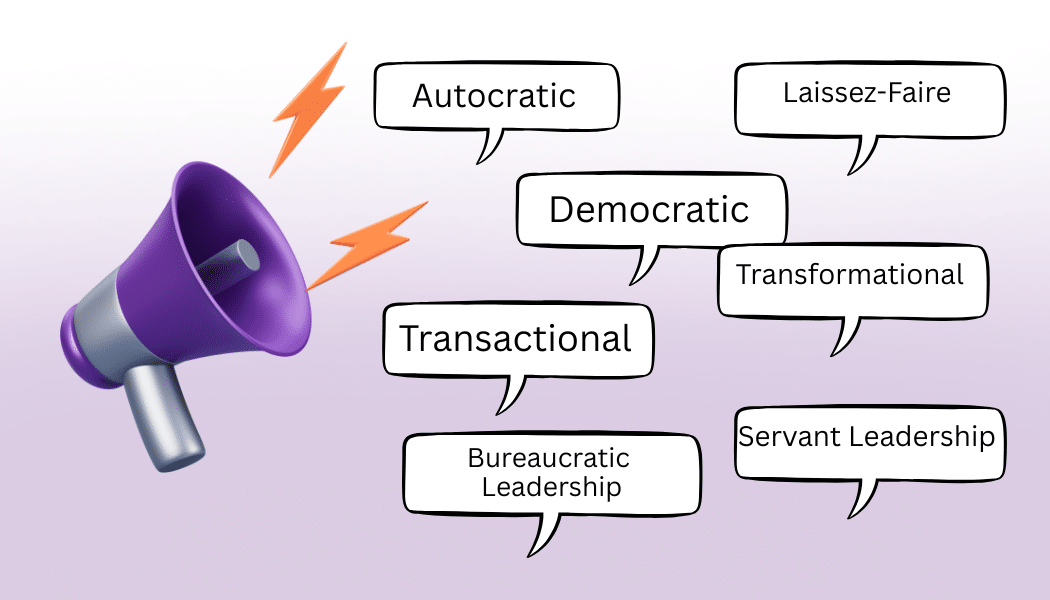DISC. Strength finders. Enneagram. We’ve all taken leadership assessments of one sort of other, and gotten our defining labels.
But here’s the thing: While the labels are clever and relevant, they’re NOT labels anyone else would naturally come up with to describe you as a leader. And that makes them a lot harder to learn from.
So let’s play a quick game.
Ask yourself: What’s the one word people would use to describe your leadership style—especially when you’re not in the room?
That’s the question at the heart of this week’s reflection and 2-question poll.
Because yes, leadership is multifaceted. Yes, we evolve and adapt. And yes, we all wish we could describe ourselves with five hyphenated adjectives to showcase our brilliance.
But here’s the reality: we leave people with a core impression.
We don’t get to write our own label—they do.
The Leadership Styles Cheat Sheet
Here are seven (plus one bonus) common types of leadership styles, each with signature strengths—and a few caution flags. Take a look and ask yourself:
→ What’s your primary or dominant style?
1. Autocratic (Authoritarian) Leadership
- Strengths: Decisive, efficient, thrives in crisis.
- Watch out: Can stifle creativity and morale if overused.
- Think: General Patton meets Elon Musk.
2. Democratic (Participative) Leadership
- Strengths: Inclusive, collaborative, builds trust and buy-in.
- Watch out: Can slow down decision-making or feel leaderless.
- Think: Oprah in a team huddle. Everyone has a voice, but decisions take time.
3. Transformational Leadership
- Strengths: Visionary, inspirational, drives innovation and growth.
- Watch out: Big dreams require clear execution plans, or it’s just dreaming.
- Think: Satya Nadella reinventing Microsoft culture from the inside out.
4. Transactional Leadership
- Strengths: Structured, reliable, delivers on goals.
- Watch out: Can feel rigid, uninspiring, or overly tactical.
- Think: The coach who runs a tight ship and gets results, but may not ask (or care) how you’re feeling.
5. Laissez-Faire (Delegative) Leadership
- Strengths: Hands-off, empowers autonomy, trusts the team.
- Watch out: Risk of lack of direction or accountability.
- Think: The “cool” professor who trusts you to figure it out—for better or worse.
6. Servant Leadership
- Strengths: Empowers others, builds trust and loyalty.
- Watch out: Can be seen as “too soft” or avoidant of tough calls.
- Think: Ted Lasso. Heart first, but sometimes you still need to win the game.
7. Bureaucratic Leadership
- Strengths: Ensures fairness, compliance, consistency.
- Watch out: Can kill innovation with red tape.
- Think: Government leadership at its best—and at its most maddening.
Bonus Style: The Avoider (Not a true leadership style per se—more of a self-protective habit.)
- Strengths: Seeks harmony, reduces tension short-term.
- Watch out: Avoids conflict, tough conversations, or accountability.
- Think: “Let’s not rock the boat”… until it sinks.
If that hits close to home, you’re not alone. Many leaders avoid confrontation because they’re afraid of damaging relationships, of being disliked or unpopular. Ironically, the lack of confrontation is what usually damages them most.
Follow-Up Reflection: What Are You Missing?
After you name your primary leadership style, here’s the second question:
Which qualities from other styles do you think you need at least a little more of in your toolkit?
In other words—what’s your weak spot?
Most of us resist embodying traits or practices that we associate with certain styles for one of two reasons:
1. We’re afraid of it. Consider:
- The authoritarian leader who avoids being more democratic because they fear losing control, power, or respect.
- The democratic leader who avoids being more decisive because they fear making a mistake and having to take responsibility for the call.
- The servant leader who avoids confrontation, believing it will damage relationships.
2. We have a limiting belief that traits across these styles can’t coexist. Consider:
- Leaders who believe it’s not possible to hold people accountable and be empathetic
- Those who believe it’s “inconsistent” to choose whether to make collective or unilateral decisions on a case-by-case basis
- Leaders who wait too long to intervene when there’s clearly a problem so as not to “micromanage”
This reminds me of many high-achieving women leaders I’ve coached who’ve been told they’re “too intimidating” or “too aggressive.” In frustration, they tell me:
“I’ve tried being nice, but that didn’t work. So what am I supposed to do?”
Here’s what I tell them: It’s not a binary, black-and-white choice.
It’s about emotional intelligence, situational awareness, and diplomatic finesse: you can be
- both flexible and steadfast in your boundaries.
- compassionate and decisive.
- collaborative and commanding.
That’s not “inauthentic.” It’s adaptive.
Leadership Growth = Style Integration
This is one of the most common challenges I help clients work through in executive coaching for leaders.
How do you know if you need help with those “diplomatic finesse” skills? Ask yourself if you are:
- A conflict-averse leader who needs to confidently and competently be able to have the hard-but-necessary conversations
- A results-driven, “get-it-done” leader who needs to slow down just enough to understand what’s going on with your team members and other stakeholders, in order to get real buy-in
- Someone who lives by the “it’s not personal, it’s just business” philosophy, occasionally leaving bodies in your wake, metaphorically speaking, and realizes the value to be gained from learning to read the room, and make a point without making an enemy
If any of these sound painfully familiar, it might be time to reassess—not your title or your task list, but your impact.
You don’t have to go it alone. And if your leadership team struggles with an array of blind spots, it might be time for some joint leadership training, too.
Drop me a line here and let’s explore how coaching or custom training might help you become the kind of leader you (and your team) always hoped you could be.
️ Poll Time: What’s Your Leadership Style?
Take today’s two-question leadership poll and let us know:
Question 1: What’s your dominant leadership style?
Question 2: From which style do you perhaps need to “borrow” some qualities? (without borrowing the negativity associated with that label.)
Bonus challenge: Share this with your team. Do their perceptions align with yours?
Because the most powerful leaders aren’t just self-aware—they’re others-aware.
Your leadership legacy starts with one word… then grows from there.
What’s yours?



